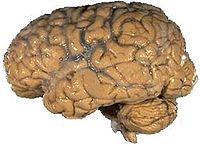User:Psychofarm/Sandbox

The Opensource Handbook of Neuroscience
Neuroscience is a field that is devoted to the scientific study of the nervous system.
This wikibook Neuroscience is devoted to the scientific study of the nervous system. Such studies may include the structure, function, development, genetics, biochemistry, physiology, pharmacology, and pathology of the nervous system. Traditionally it is seen as a branch of biological sciences. It can involve convergence of interest from many allied disciplines, including psychology, computer science, statistics, physics, and medicine. The scope of neuroscience has now broadened to include any systematic scientific experimental and theoretical investigation of the central and peripheral nervous system of biological organisms. The methodologies employed by neuroscientists have been enormously expanded, from biochemical and genetic analysis of dynamics of individual nerve cells and their molecular constituents to imaging representations of perceptual and motor tasks in the brain. Neuroscience is at the frontier of investigation of the brain and mind. The study of the brain is becoming the cornerstone in understanding how we perceive and interact with the external world and, in particular, how human experience and human biology influence each other.
- Google Search in this book
- Wikimedia Commons Neuroscience with files for this book
- This book is under construction - hope you will join the effort to create it!
| Brief introductions to the parts
to give a quick overview |
Detailed descriptions
(-icons are individual web pages; Numbers are sub-sections) | |||
|
Why is nanotechnology such a 'hot' subject - and is it more hype than substance? This part gives a brief introduction to the visions of nanotechnology and why so many people are working on it around the world. To help set a perspective there are overview tables with timelines, length scales and information resources. |
|
|
|
|
|
Microscopes allows us to probe the structure of matter with high spatial resolution, making it possible to see for instance individual atoms with tools such as the scanning tunneling microscope, the atomic force microscope, and the transmission electron microscope. With the related spectroscopic methods, we can study the energy levels in nanosystems. This part gives an overview of the tools and methods used in microscopy and spectroscopy of nanostructures. |
|
|
|
|
|
On the nanoscale force that we in everyday life do not consider strong, such as contact adhesion, become much more important. In addition, many things behave in a quantum mechanical way. This chapter looks into the scaling of the forces and fundamental dynamics of matter on the nanoscale. |
|
|
Physical Chemistry of Surfaces
|
|
|
Many unique nanostructured materials have been made, such as carbon nanotubes that can be mechanically stronger than diamond. This part provides an overview of nanoscale materials such as carbon nanotubes, nanowires, quantum dots and nanoparticles, their unique properties and fabrication methods. |
Overview of Production methods
|
|
|
|
|
To understand the novel possibilities in nanotechnology, this part gives an overview of some typical nanoscale systems - simple experimental devices that show unique nanoscale behavior useful in for instance electronics. |
|
|
|
|
|
Combining nanodevices into functional units for real life application is a daunting task because making controlled structures with molecularly sized components requires extreme precision and control. Here we look at ways to assemble nanosystems into functional units or working devices with top-down or bottom-up approaches. See also the Wikibook on Microtechnology which contains information about many fabrication and processing details. |
Top-down and bottom-up approaches
|
|
|
|
|
Your body is based on a fantastic amount a biological nanotechnology happening right now in each of your body's cells, that has evolved to an awesome level of complexity. Much of nanotechnology is aimed at bio-applications, such as bio-sensors and biologically active nanoparticles for medical therapy or targeting cancer. This part is an introduction to this cross-disciplinary field. |
|
|
|
|
|
People are very enthusiastic about the visions of nanotechnology, but at the same time there is a natural worry about the environmental issues of the emerging technologies. This area is being increasingly brought into focus to ensure a healthy development. |
Health effects of nanoparticles
|
|
|
|